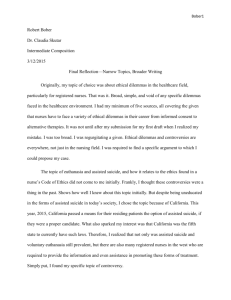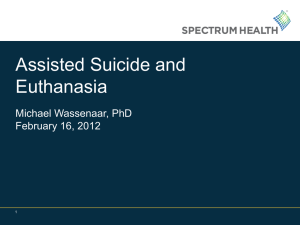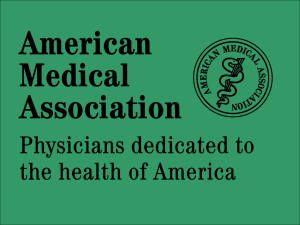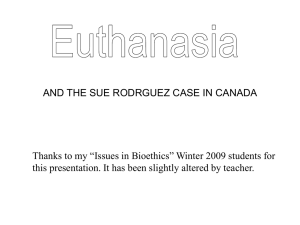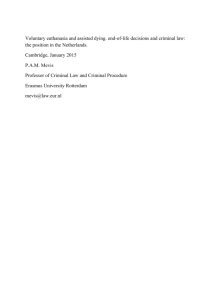Euthanasia #1.doc
advertisement
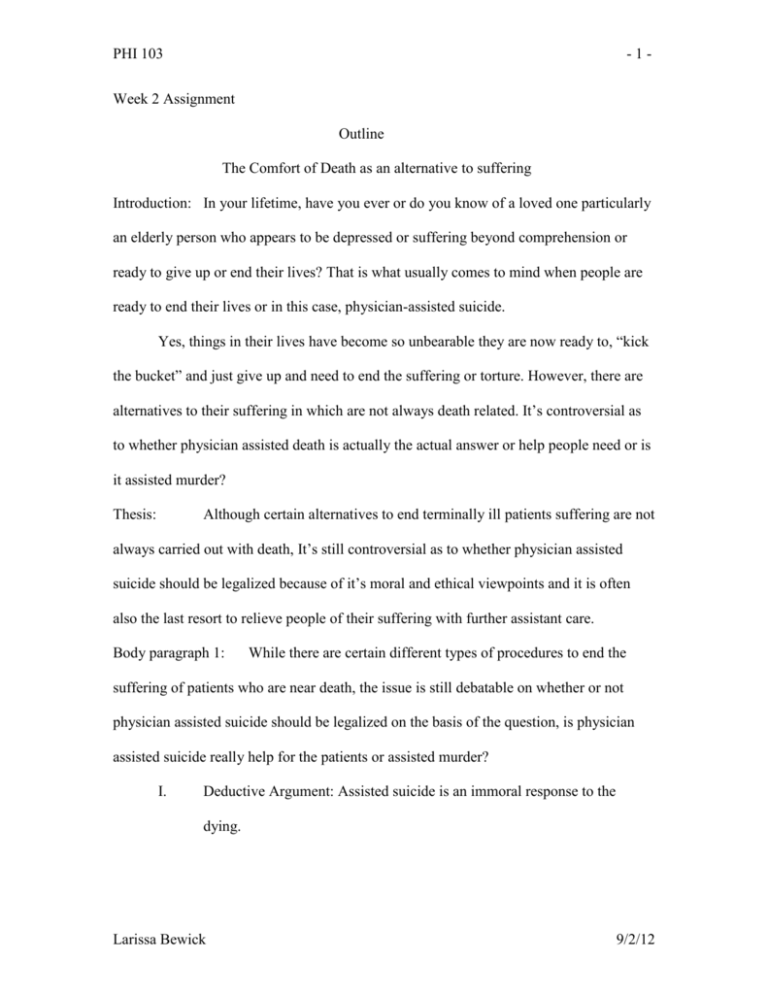
PHI 103 -1- Week 2 Assignment Outline The Comfort of Death as an alternative to suffering Introduction: In your lifetime, have you ever or do you know of a loved one particularly an elderly person who appears to be depressed or suffering beyond comprehension or ready to give up or end their lives? That is what usually comes to mind when people are ready to end their lives or in this case, physician-assisted suicide. Yes, things in their lives have become so unbearable they are now ready to, “kick the bucket” and just give up and need to end the suffering or torture. However, there are alternatives to their suffering in which are not always death related. It’s controversial as to whether physician assisted death is actually the actual answer or help people need or is it assisted murder? Thesis: Although certain alternatives to end terminally ill patients suffering are not always carried out with death, It’s still controversial as to whether physician assisted suicide should be legalized because of it’s moral and ethical viewpoints and it is often also the last resort to relieve people of their suffering with further assistant care. Body paragraph 1: While there are certain different types of procedures to end the suffering of patients who are near death, the issue is still debatable on whether or not physician assisted suicide should be legalized on the basis of the question, is physician assisted suicide really help for the patients or assisted murder? I. Deductive Argument: Assisted suicide is an immoral response to the dying. Larissa Bewick 9/2/12 PHI 103 -2A. “There is belief it is wrong to prevent a person from having a choice at the end of their lives. 1. Patients should be responsible for their own suffering. 2. People have a right to decide when and how to end their own lives. B. Patients who are being kept alive by technology and want to end their lives also have a constitutional right. C. II. 74.4 % of students in Pakistan opposed legalization. Inductive Argument: Physician-assisted suicide is helpful and should be legalized. A. Assisted suicide can be a compassionate response to the dying. 1. Physician-assisted suicide is a win-win situation. 2. People with out health insurance choose suicide to save society and their families from caring for them. a. Euthanasia has been legalized in some European countries and states just not Oregon and Michigan. b. Doctors who end patient’s lives could justify their actions as an appropriate procedure. B. The source, Introduction to Logic indicates the (Slippery Slope argument) “When euthanasia becomes a law it will start out as a voluntary basis for the mentally ill and then it will become available to anyone, even those who don’t benefit the system.” (Mosser, 12) That’s not the only debate because also according to the text, “For many people knowing how to kill themselves in itself is a great comfort.” (p. 22) Larissa Bewick 9/2/12 PHI 103 -3- Body Paragraph #2 Additionally, There is also debate whether the issue is betrayed as moral or ethical because it is often referred to by people as, assisted-murder. I. There is a difference between killing and wanting to die. A. Society must not allow doctors to be killers as well 1. Authors opinion: “Killing is always wrong because all human life has intrinsic value. 2. Even if one could adequately describe the difference between killing and allowing people to die, then the distinction would make a moral difference. a. Intention is the key, explaining the wrongness that all acts of killing patients have in common with the wrong acts of allowing patients to die. b. In other words, killing and allowing patients to die are not the same thing, because all killing of patients is morally wrong while allowing some patients to die is not, then the moral of evaluation would then be based on intention.” (p. 32) c. Ethical prohibits against physician participation in capital punishment is torture are examined. d. The practice is fraught with ethical, moral and social controversy. B. Larissa Bewick Euthanasia violates Christian beliefs 9/2/12 PHI 103 -41. Authors view from source, Euthanasia: “All persons because they have created by God, have a dignity that is not diminished by their suffering or dependence on others.” (Torr, 33) 2. To illustrate further in the text, “How we face the mysteries and of suffering, dying and death makes a critical difference for us loved ones.” (34) a. In Pakistan University, students cited religious beliefs against legalization. Body Paragraph #3: The issue of physician-assisted suicide or the act of death and dying is a last result to any other alternative care for patients such as further assisted advances care or psychotherapy or higher dosage of medication. To illustrate, I. Dying patients should have access to both Hospice Care and assisted suicide. A. The importance of Hospice Care. 1. According to James D Torr, “In acute care medicine where we ask people to endure considerable suffering in the interest of potential recovery and then return to meaningful life.” (p. 106) B. Hospice and Experimental Treatment 1. It’s unrealistic to expect hospice to relieve all suffering. 2. However there is also a terminal sedation, which offers the patient the option to be heavily sedated, not assisting death but rather relieving suffering. Larissa Bewick 9/2/12 PHI 103 -5C. Another alternative dying patients should have access to is to protect the vulnerable according to the text, Introduction to Logic, “The slippery slope argument implies that once the right to voluntary medically assisted euthanasia is legalized, it will become incumbent upon the handicapped, frail elderly and others to rid society of their presence because they feel that they are a burden to society.” (Mosser, 142) Also as the text goes on to state, “Disabled people have every right to protect their interests but not at every one else’s expense.” (Mosser, 142) Also, “Under false assumptions according to Mosser in the text, “The Slippery Slope argument rests on fatalistic assumptions that we have little control over our final destines.” (p. 128) I also believe according to my personal belief system and others who believe the same thing would agree as well, Religion would be the last resort regarding life or death, because as the Bible states, “Those who trust and hope in the Lord will renew their strength.” (Ephesians, 1-3) Body Paragraph #4: Finally, to illustrate this point further, what we must also comprehend about this physician-assisted death is the alternatives to the patients suffering are not always death and suicide related. I. Family assisting, Medicare assistance are all options of the near-dying patients. A. However, according to the text, “The lives of family members assisting the terminally ill are compromised and overwhelmed because the burdens of providing constant care to the patients 24/7 and as result of that, the caregivers life becomes destroyed. Larissa Bewick 9/2/12 PHI 103 -61. Also financial burdens of caring for terminally ill patients can be devastating. B. Much suffering comes from unkind treatment from unkind caregivers. 1. Technology creates advantages and disadvantages as well as medical advances such as anti-depressants and joint replacements. 2. Another question regarding alternative treatment is; do we play God by terminating a natural process? 3. What possible sense does it make to use limited resources on people who cannot and do not want to be helped? Conclusion: Now that it is evident that physician assisted suicide is not necessarily the best alternative after all to relieve patients of their suffering or the last resort alternatives depending upon peoples religious beliefs and viewpoints or their belief of God or a higher powers assistance in their final destination. Larissa Bewick 9/2/12 PHI 103 -7References Dudley, William. (2000) Opposing Viewpoints in Social Issues. Should Assisted Suicide be Legal? (Ch. 6) pages, 204-243 Lepora, Chiara. (May/June 2011) Pages, 38-47 Retrieved from: http://search.proquest.com/docview. Mosser, Kurt (2011) Introduction to Literature Ch. 4, pages. 1-26. Retrieved from: https://content.ashford.edu. Shaikh, MA (Oct. 2011) Beliefs about Euthanasia among University Students: Perspectives from Pakistan/Croyances. Eastern Mediterranean Switzerland Health Journal 17.10 pages 794-797. Retrieved from, http://search.proquest.com. Stacy, Kathleen M. (2012) Withdrawal of Life-Sustaining Treatment (A Case Study) Vol. 32, No. 3 pages 14-22. Retrieved from: http://www.cconline.org. Torr, James D. (2000) Euthanasia: Opposing Viewpoints (Opposing Viewpoint Series) Green haven Press Inc. San Diego, California. Ch. 1-4. Trugg, Robert, D. (2011) Are their things Doctors Just Shouldn’t Do? The Hastings Center Report 41.3 United States. Pages. 1-2. Retrieved from, http://search.proquest.com Larissa Bewick 9/2/12
